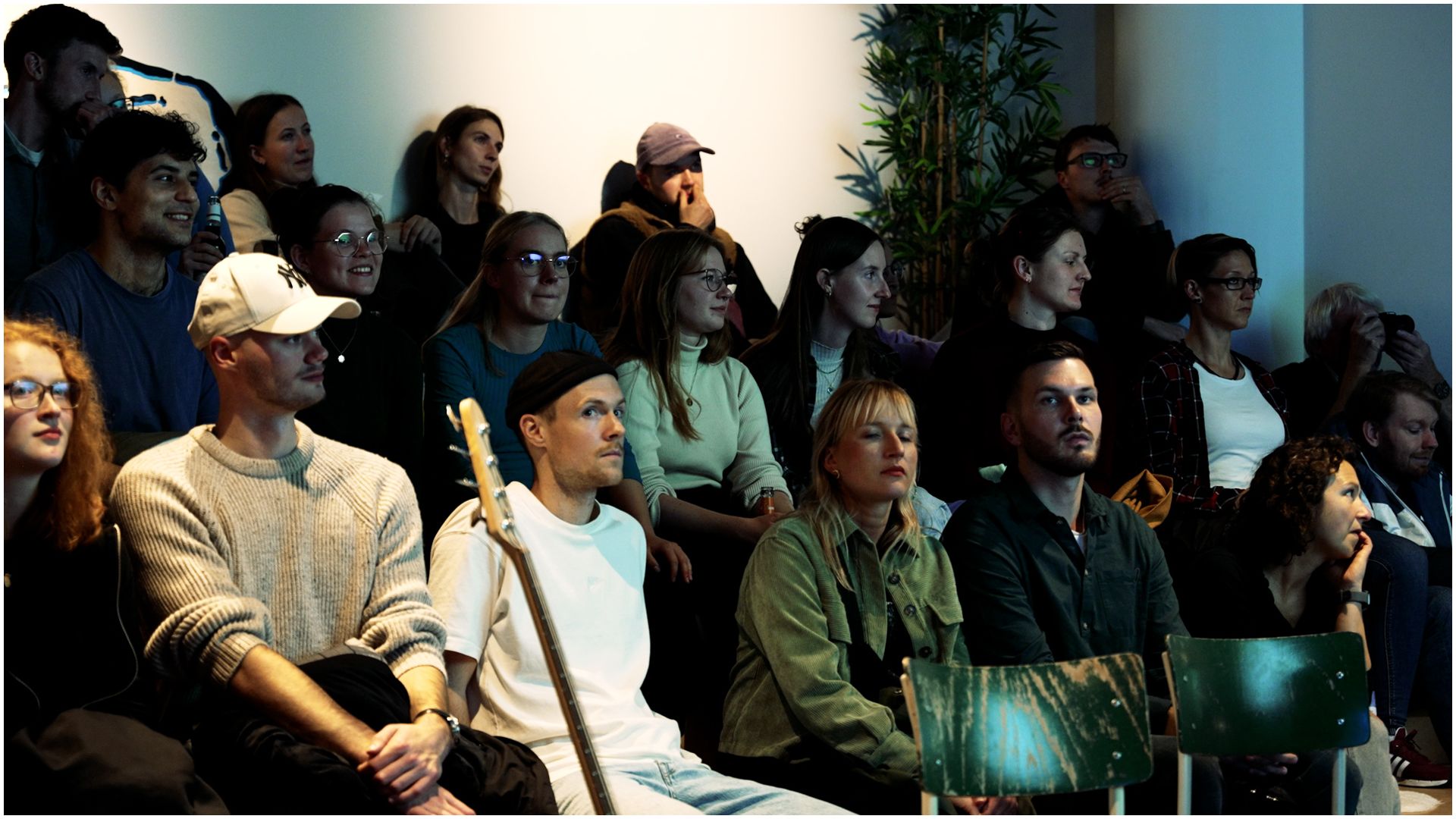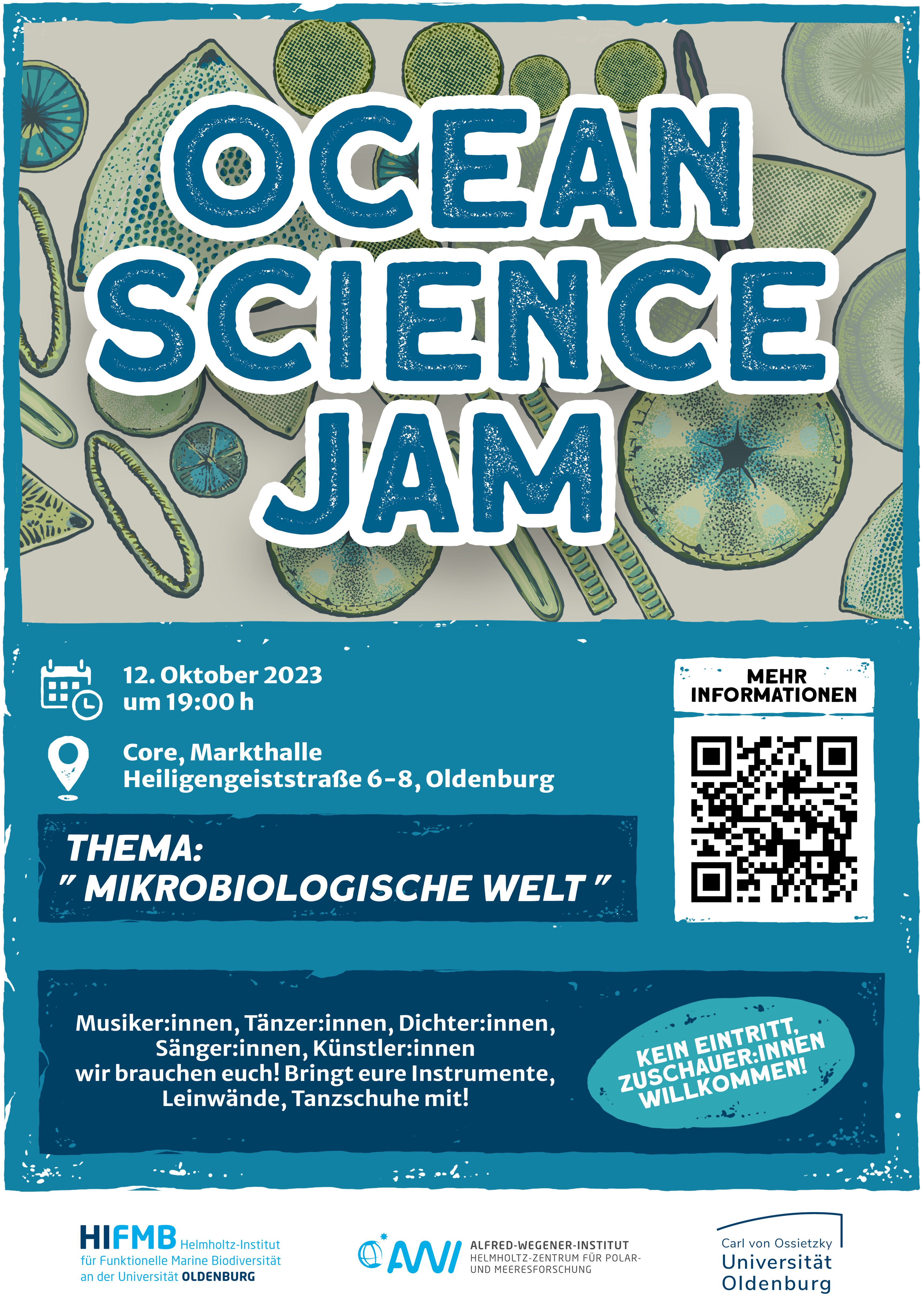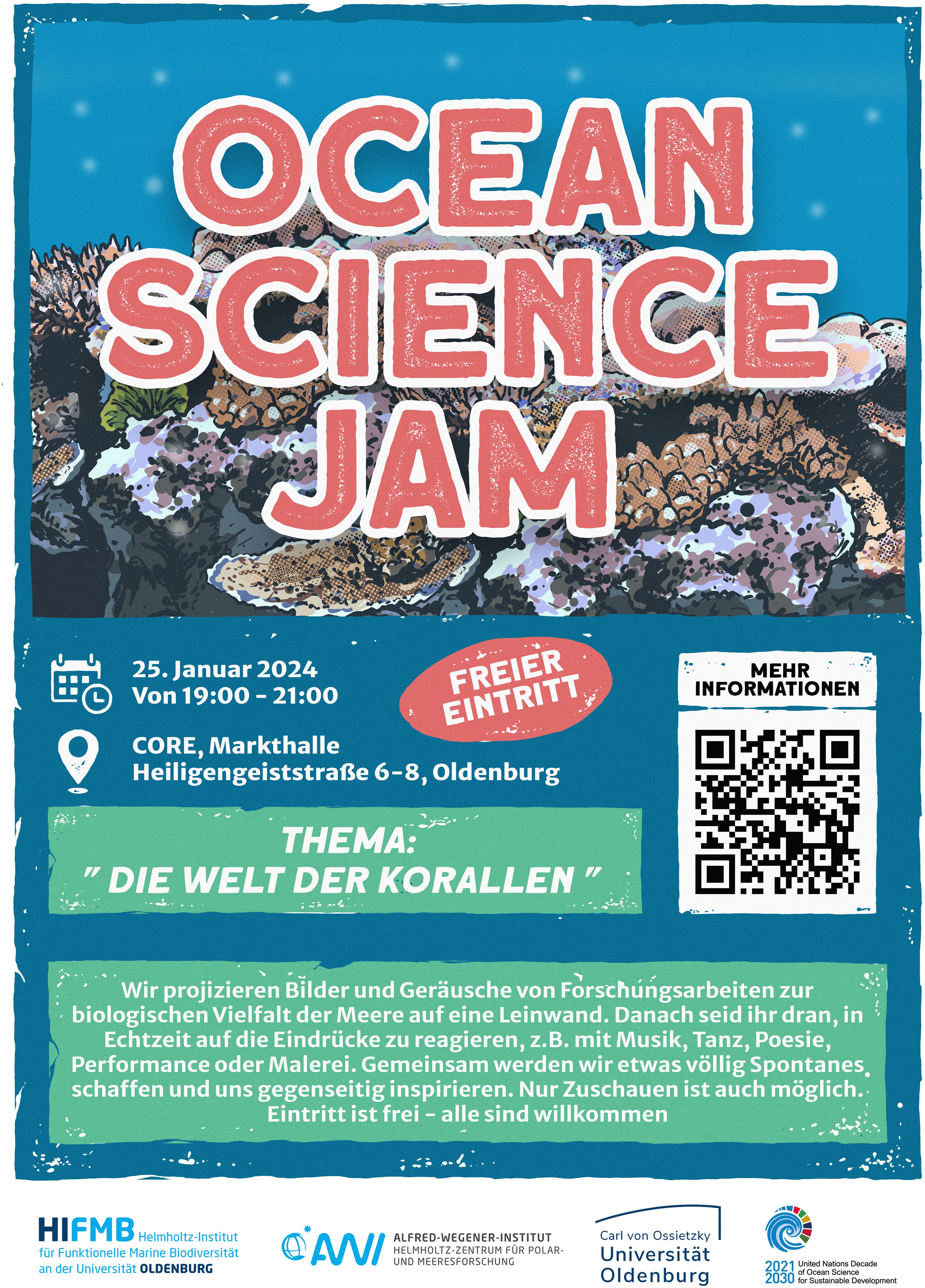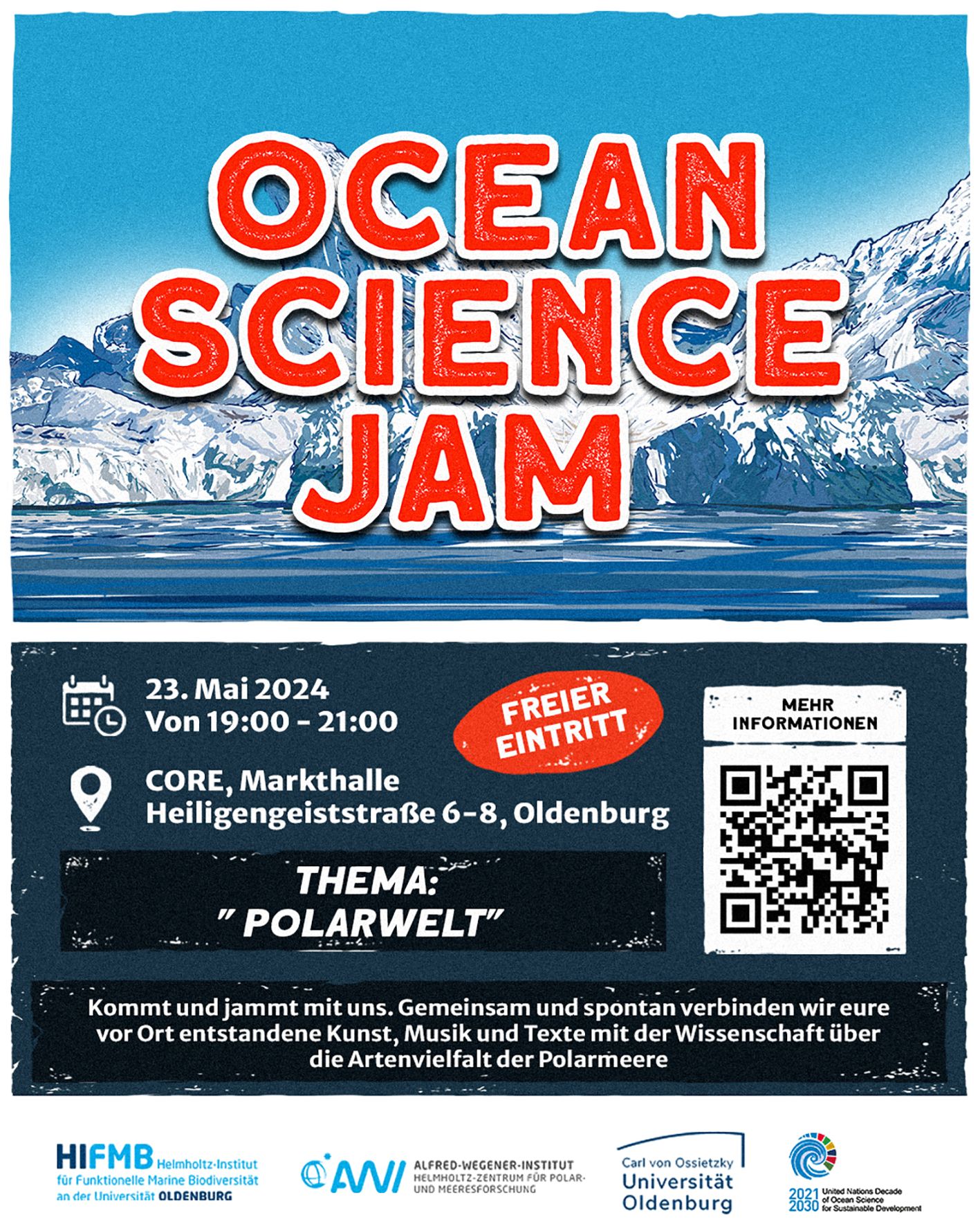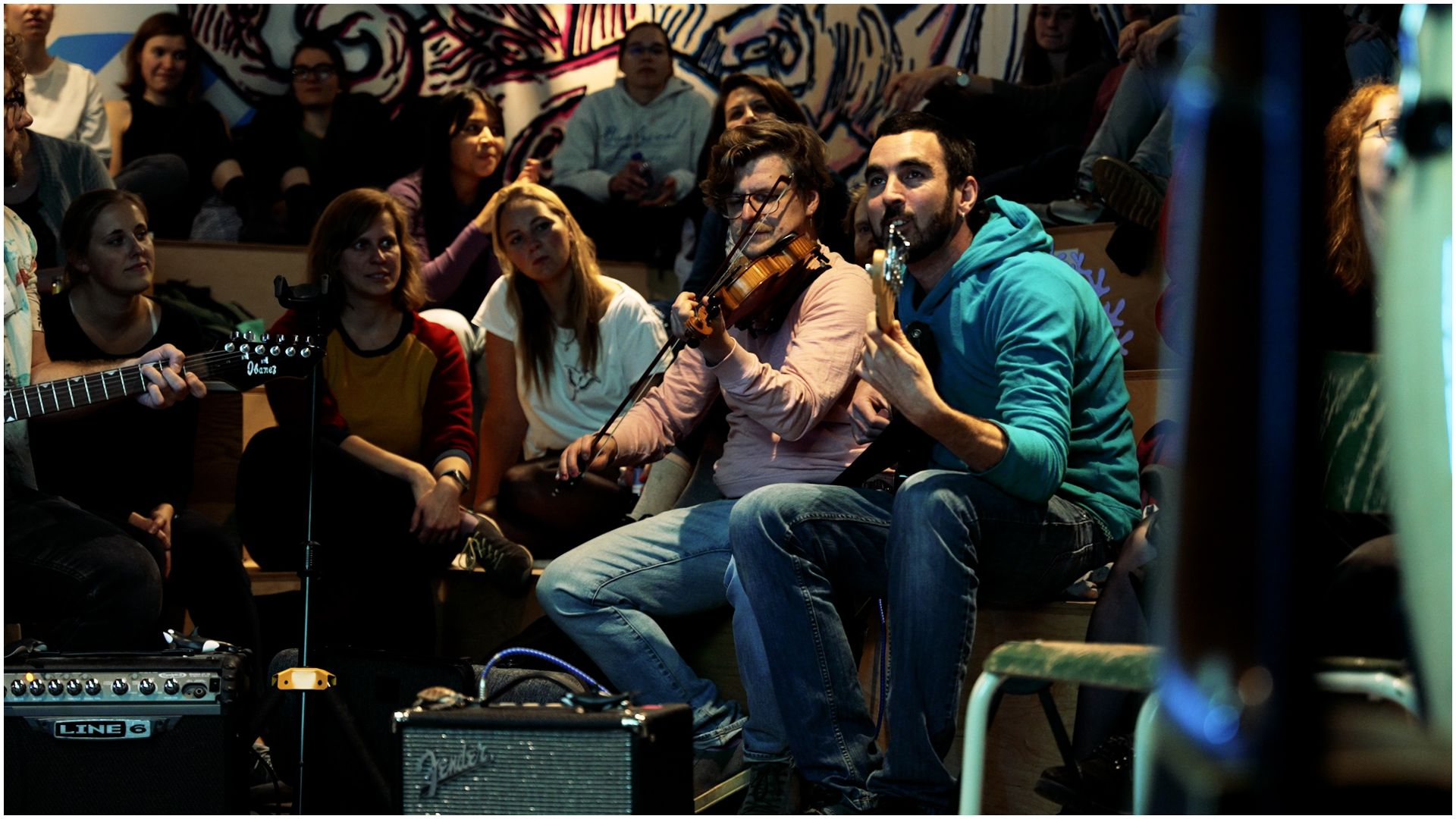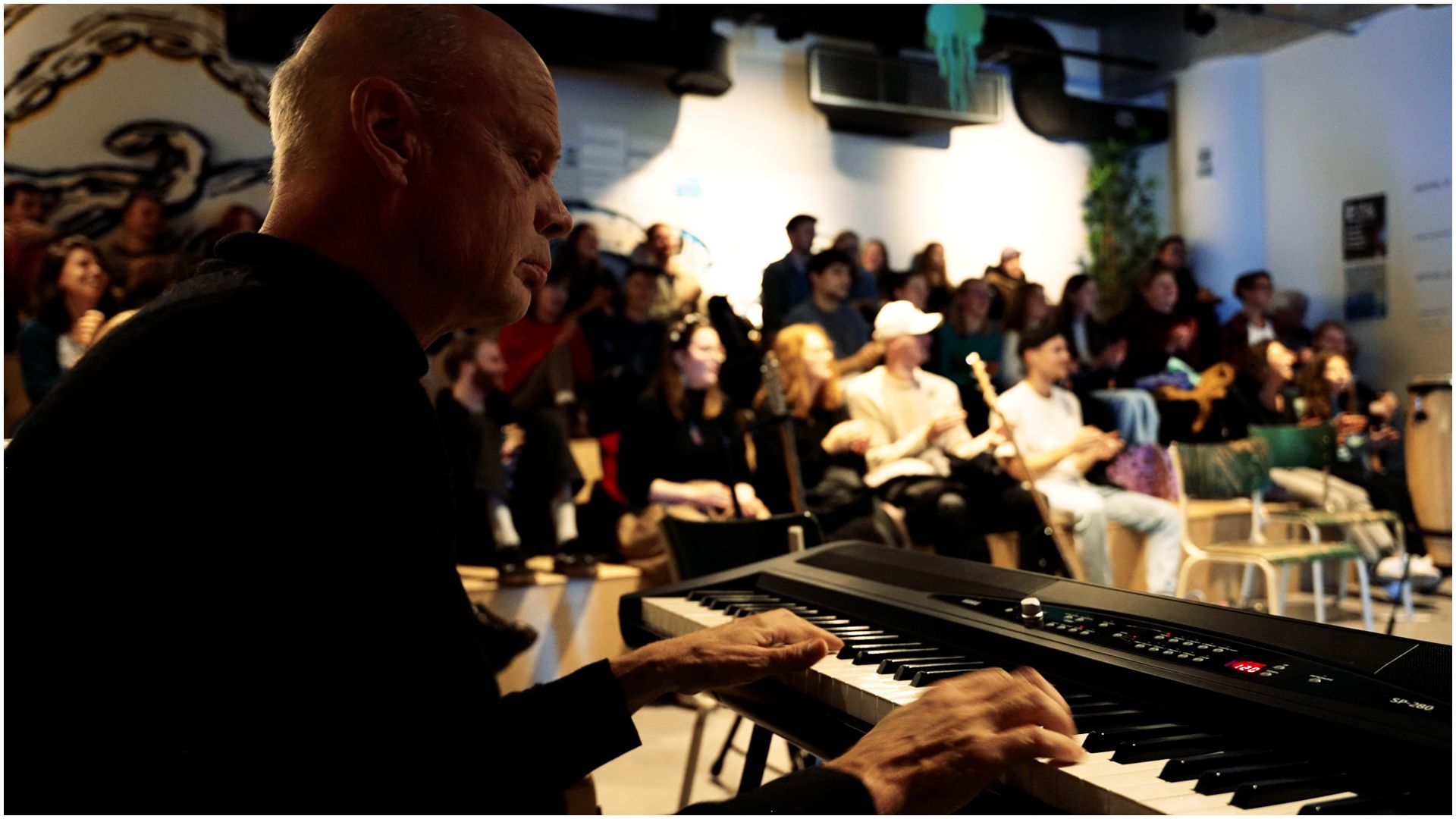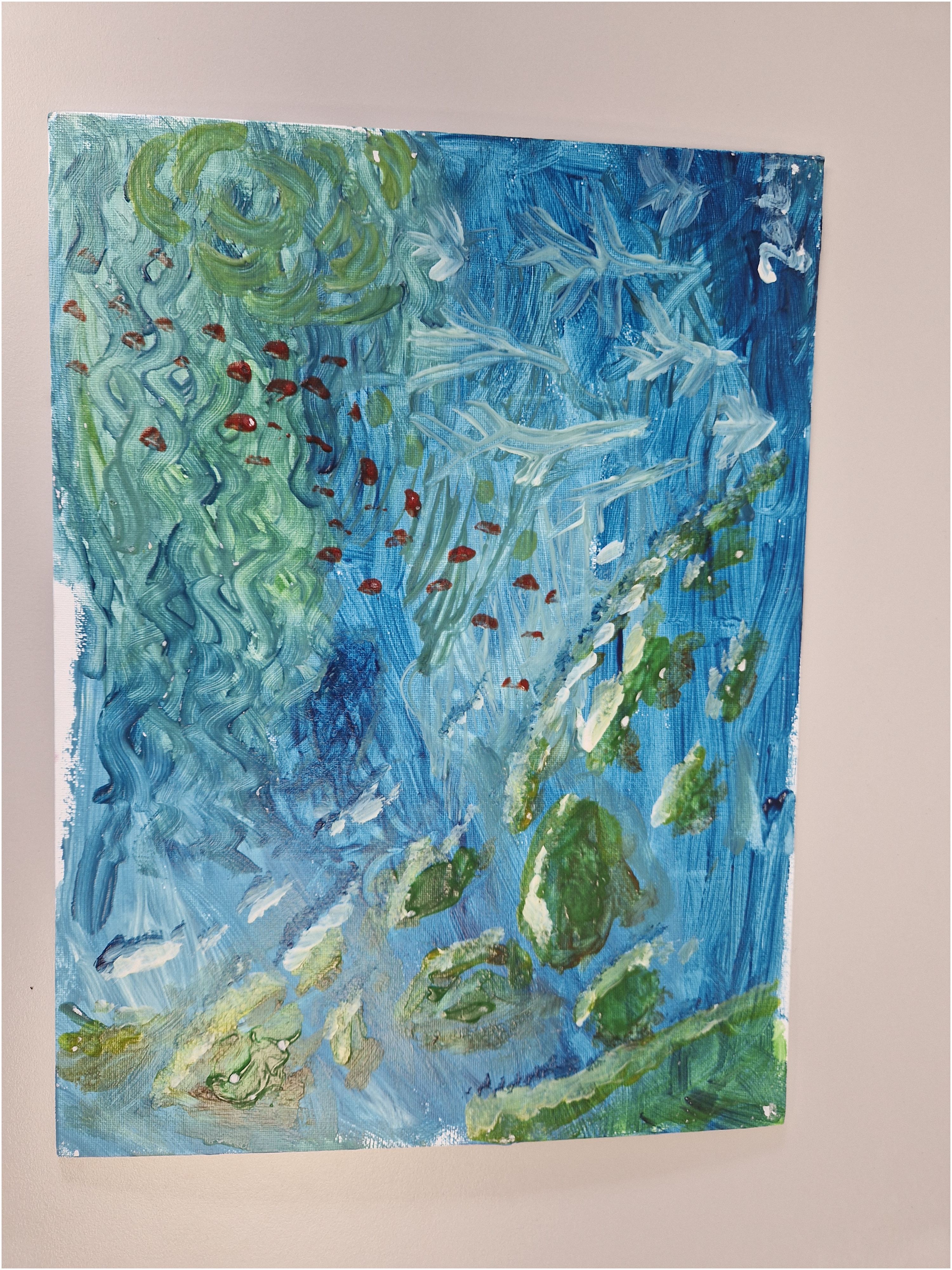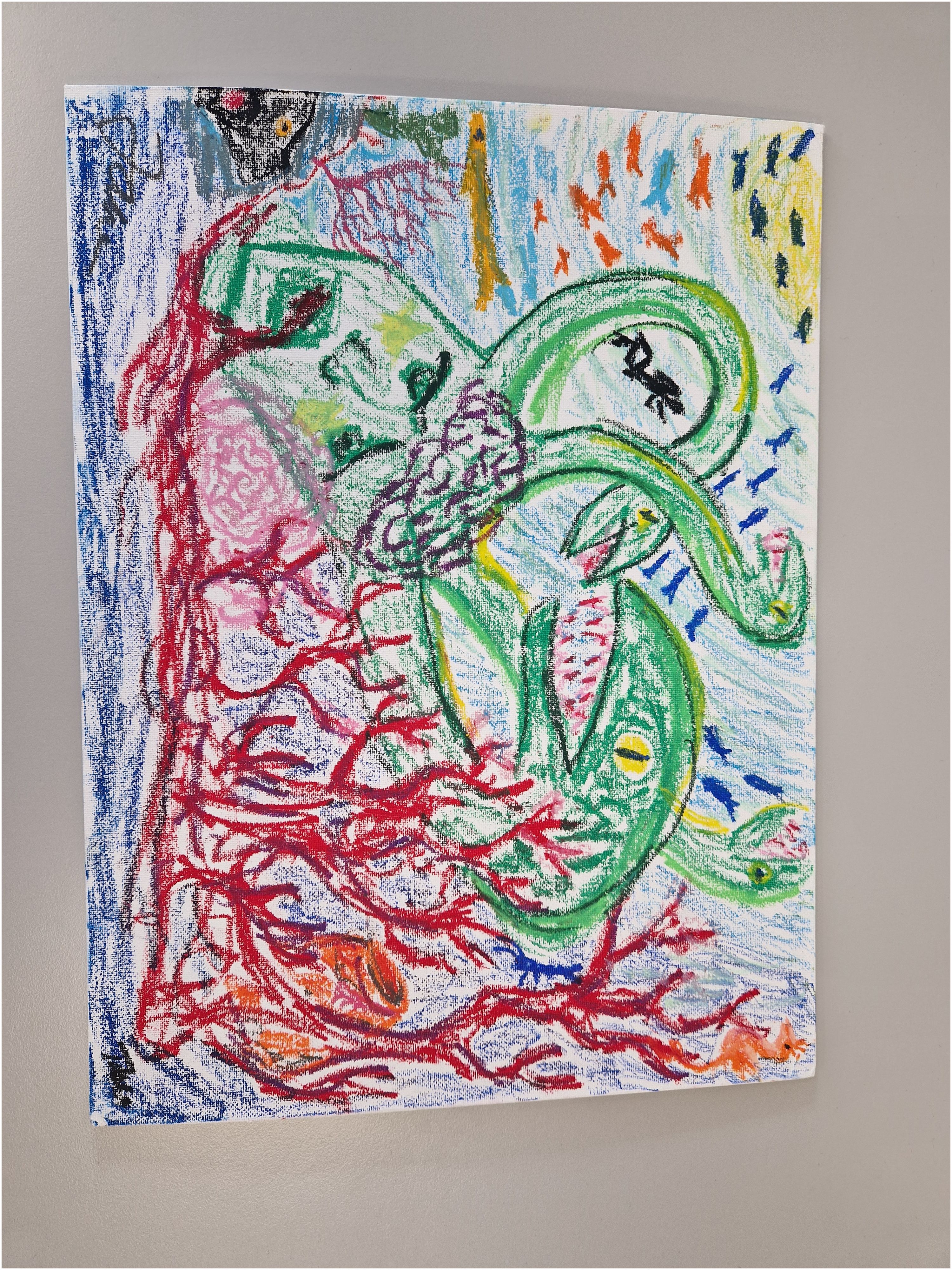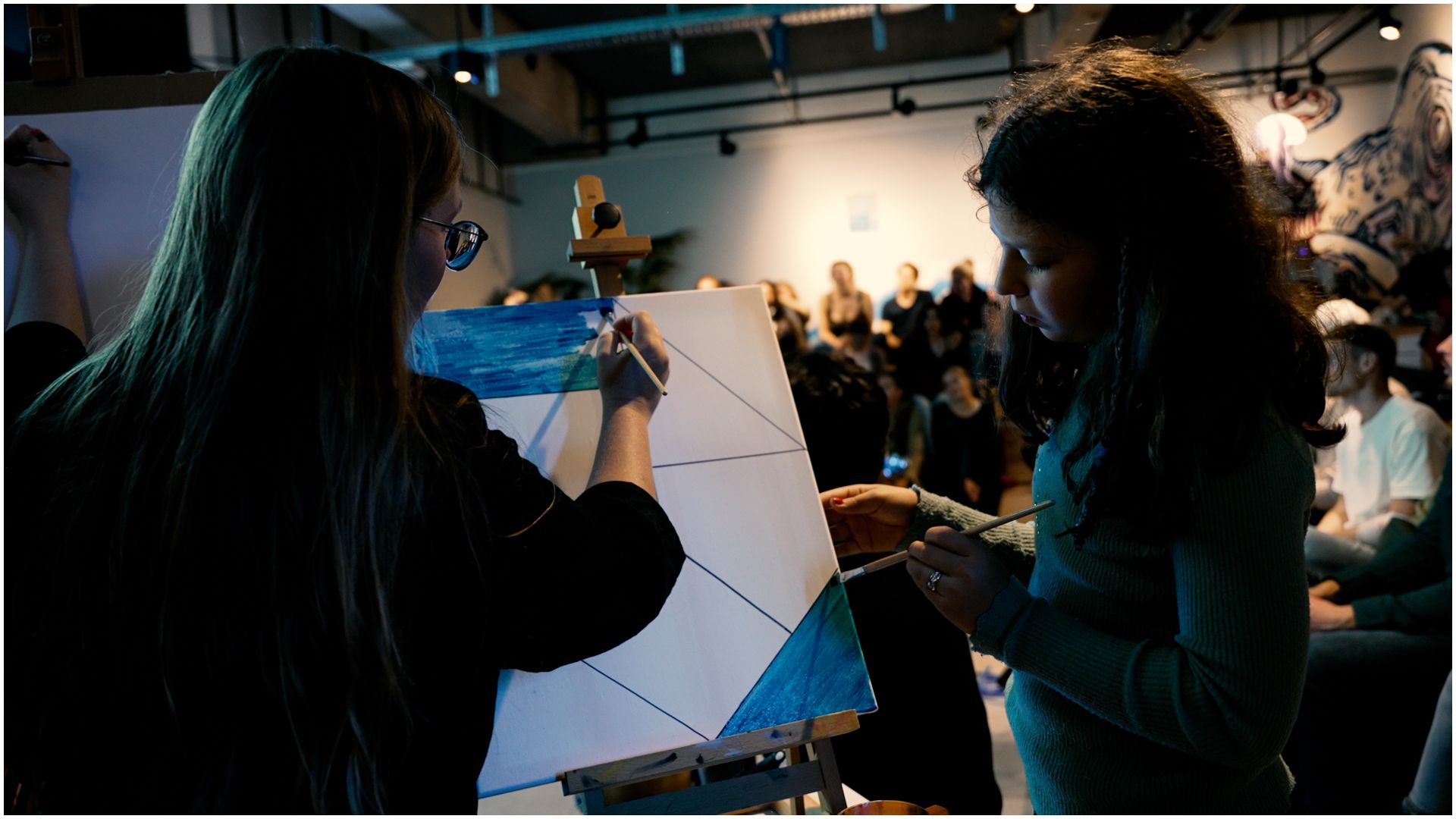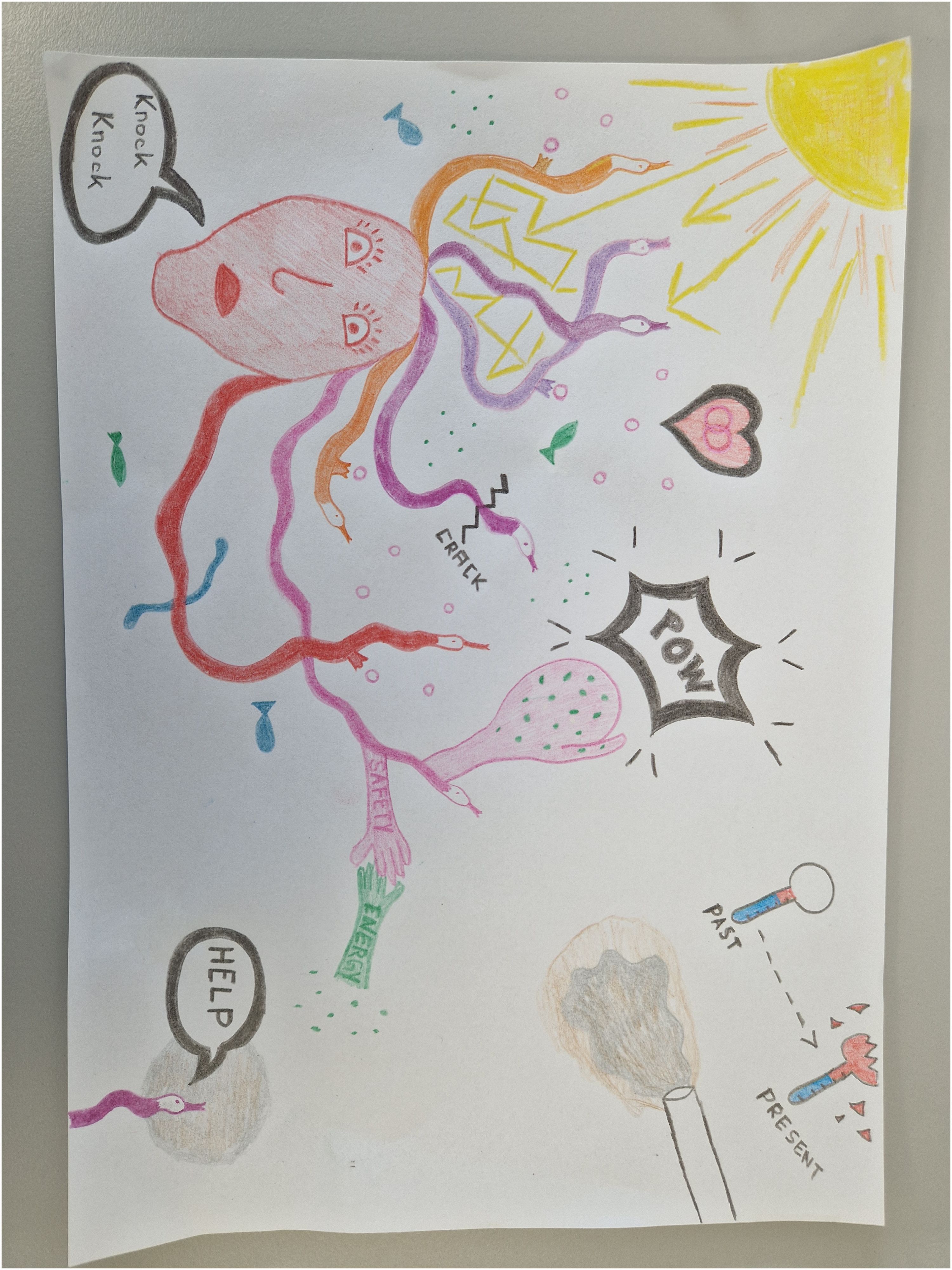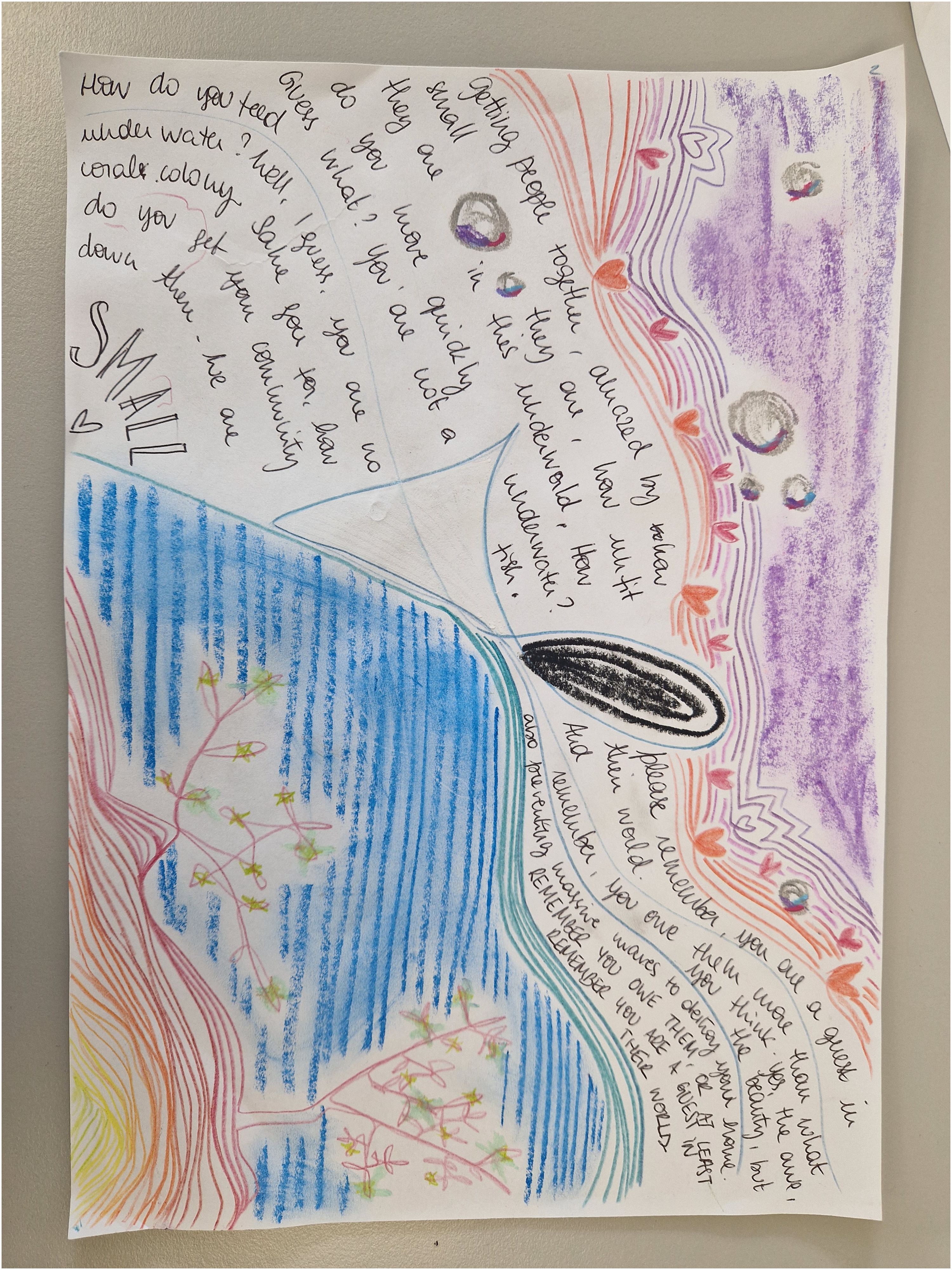- 1Helmholtz Institute for Functional Marine Biodiversity at the University of Oldenburg (HIFMB), Oldenburg, Germany
- 2Alfred Wegener Institute Helmholtz Centre for Polar and Marine Research, Bremerhaven, Germany
Sharing complex oceanic research in an accessible way with the public is being identified by scientific institutions, universities, governmental departments, and NGOs as a critical intervention in promoting better engagement with the sea. Art–science collaborations play an integral role in this. Traditionally, these involve pairing artists and marine scientists to work on a project which is then presented to an audience. Increasingly however more interactive relationships with the public are being seen as a beneficial way to merge art and scientific data. The Ocean Science Jam is such a project that brings musicians, artists, dancers, performers, and the public together to respond creatively in real time to visual and audio cues based on a theme related to marine scientists’ work. By mixing creativity with science in an integrative way the Ocean Science Jam not only acts as tool for public communication but also opens new ways for scientific data to be interpreted by non-scientists. This paper will explore this initiative from design to delivery highlighting the results of facilitating with the public moments where new responses to ocean science can be created through art. It will do so by combining the reflections of the creator of the Ocean Science Jam as well as feedback from the scientists and public who have participated. It will argue for the benefits of using improvisation and artistic co-creation for developing moments of embodied oceanic exchange and connection.
Introduction: a song for Pelagibacter
It is a dark October Thursday evening in Oldenburg, North Germany. On one of the main pedestrianised streets in the city centre, around 70 people are gathered in a bar/street food hall, participating in the first ever Ocean Science Jam. They are located in one of the corners of the venue, at a seating area which has three rows of tiered stairs (see Figure 1). Although this seated area is usually open to the rest of the food hall, for this evening, curtains have been drawn three quarters of the way across on both sides, creating a cosy, intimate atmosphere. The audience’s eyes face forward, fixed on a projector screen. It is the focus point of the evening. On it, various images, videos and sounds related to the night’s theme, the microbial world of the oceans, have been projected, each accompanied by explanations on what is being shown by Dr Florian Trigodet, who is the scientist for the evening.
The audience, which consists of the general public have been encouraged throughout the night to react to the ocean science presented to them in any way they want, be it through musical expression (three guitars, a keyboard, a cajon, and a Conga drum have been set up for anyone to use), through painting (easels with canvases and paint have also been set up in one of the corners), by drawing or writing poetry (pens, pencils and papers have also been handed out), or any means that they want to. Anyone can respond to what they see, hear, and feel any time, taking the stage or remaining seated to do or say something. It is an open space for creative expression, spontaneity, and improvisation. No one knows what will happen next, including myself, the creator and host of the event.
So far, the evening’s prompts have included a video of marine bioluminescence, a close-up image of ocean microbes too small to see with the naked eye, and some audio clips of the tip-tapping of typing on a keyboard, a sound that represents the noises that are most present in the day-to-day office lives of the microbial scientists. Each cue has garnered diverse and surprising responses. Some of the audience members have reacted by writing and then reciting lines of poetry, some have responded through music which has developed into a jam session, others have been busy painting. The atmosphere has been a mixture of joy, apprehension, awkwardness, and fun. When someone has presented something, the audience clap in appreciation and support. Through this experimentation there has also been a lot of laughs.
We are halfway through the evening. The next cue, however, could be more challenging. Projected up on the screen is a figure taken from a paper by Delmont et al. (2019) on the single-amino-acid variants that shape the biogeography of a global SAR11 subclade. On the figure there are two panels. The top panel shows the occurrence of 6175 gene clusters. It is a circular complex looking graph with numerous colours and blocks. In the panel below is a map of the world showing the distribution across the ocean of the core genes (see Figure 2). Next to the figure are the words “Studying SAR11: the most prevalent microbe in the ocean”. As Dr Trigodet describes what we are looking at, he mentions how Pelagibacter are a member of the SAR11 group and are a fundamental part of the makeup of the cells on the ocean surface. With a sense of joy but also apprehension as to what the audience’s reaction will be, he mentions how this prompt could be a tricky one.
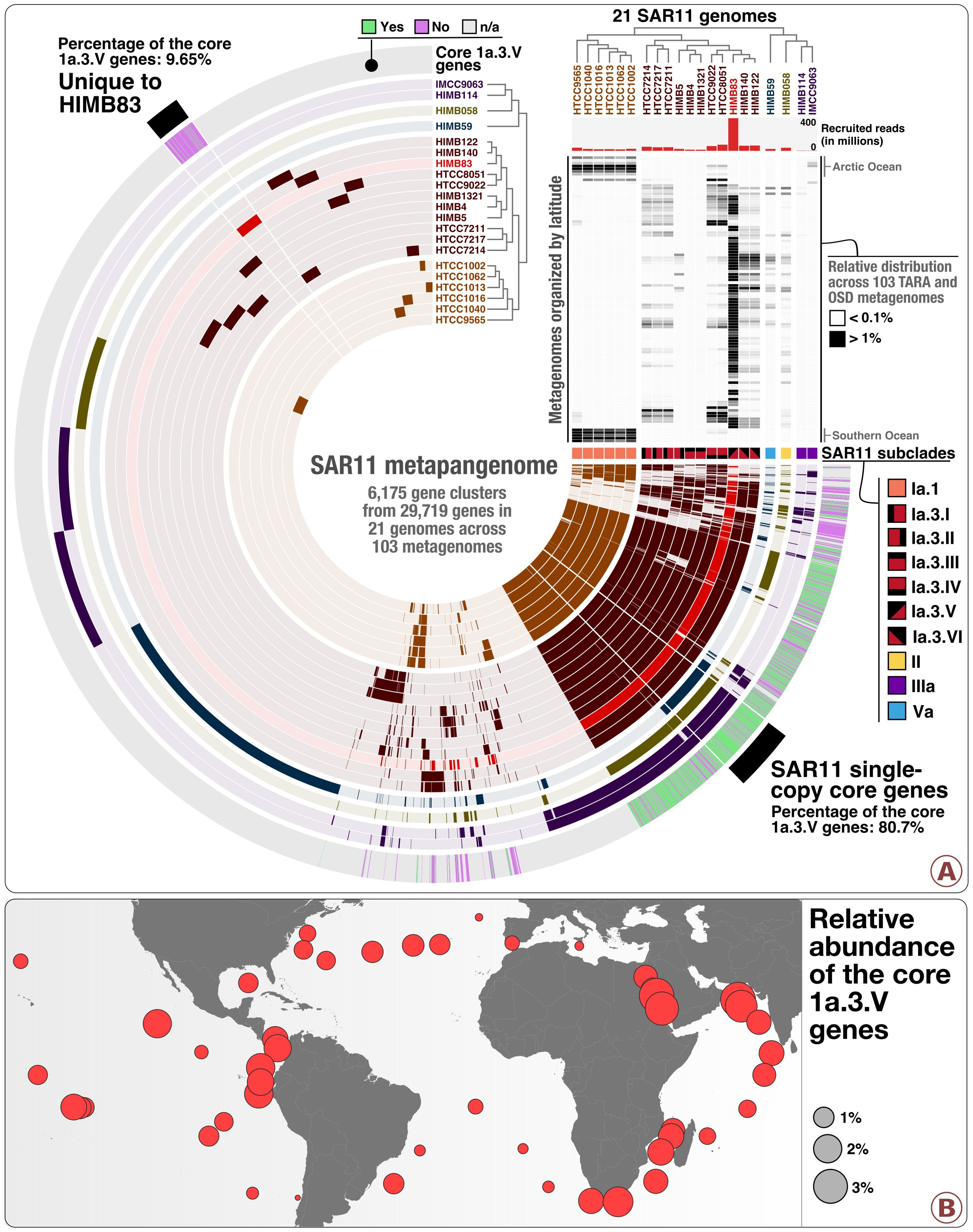
Figure 2. The SAR11 metapangenome. Panel A describes the pangenome of 21 SAR11 isolate genomes based on the occurrence of 6175 gene clusters, in conjunction with their phylogeny (clade level) and relative distribution of recruited reads in 103 metagenomes ordered by latitude from the North Pole to the South Pole (top right heat map). The relative distributions were displayed for a minimum value of 0.1% and a maximum value of 1%. The layer named “Core 1a.3.V genes” displays the occurrence of the 799 core 1a.3.V genes (in green) and those found in HIMB83 but not in the 1a.3.V lineage (in purple). Panel B describes the relative distribution of reads the 799 core 1a.3.V genes recruited across surface metagenomes from TARA Oceans. Source: Reprinted from Delmont et al. (2019), licensed under CC-BY-4.0.
At first, like has been the order of the evening, nothing happens. Silence. The audience look around for who will potentially do something as anticipation hangs in the air. What will happen next? As the roaming host, I do what I have been doing all evening, moving around the space, trying to provoke responses, and acting upon small sparks of improvisation that might be building through encouraging those who start something to keep playing, speaking and so on. A few moments later one of the audience members picks up the bass guitar and starts playing a funky, syncopated bass line which tries to mimic the shape of the image of the cluster on the screen. Another audience member then starts moving a shaker as others start playing some of the instruments in the room. Before long there is a groove building.
The bass player then starts repeating a lyrical line which he is slowly building. I move the microphone closer to his mouth so we can all hear the words that he is singing, “pelagibacter – the most prevalent microbe in the ocean”. After a few repetitions of this line, a hook has developed. Next to him another audience member starts to sing along with the lyrical line and a few moments later, many in the room are now clapping, moving and singing along to the jam that has developed. In unison, they are singing a song that a few moments ago didn’t exist, about an important ocean microbe which beforehand only the scientists knew about (Supplementary Audio 1). This goes on for around 10 minutes. The jam naturally concludes and after the excitement of the moment, we then move on to the next cue. Later, when I speak to various audience members after the evening has ended, it is this moment that stood out for many as something they won’t forget. An improvised song about pelagibacter – the most prevalent microbe in the ocean.
What has just been described is an example of the improvised, creative responses that have emerged from the Ocean Science Jam, a new project which brings together musicians, artists, dancers, performers, and the public to respond creatively in real time to visual and audio cues based on a theme related to marine scientists’ work. Understanding what the public know about the ocean, and then sharing with them complex Oceanic research in an accessible way is being identified by scientific institutions, universities, governmental departments, and NGOs as a critical intervention in promoting better engagement with the sea (Jefferson et al., 2021; Laffoley, 2014). Art-science collaborations are increasingly being seen as an important way to do this (Whittaker, 2023; Jung et al., 2022; Paterson et al., 2020; Brennan, 2018; Dupont, 2017), with the UN Ocean decade (2021–2030) initiative recognising creative projects as a critical component in the push to create an “inspiring” and “engaging” ocean for all (Whittaker et al., 2024). Indeed, the Ocean Science Jam was itself endorsed by the UN Ocean Decade and is an example of how Ocean related art–science collaborations can create opportunities for the public to have embodied experiences with the ocean and ocean science in “excess”, in other words, beyond the physical limitations of the ocean without getting wet (Peters and Steinberg, 2019). This article will reflect on the Ocean Science Jam to explore how the project developed and ask the following questions: How do the public improvise with ocean science through artistic creativity? What does improvisation give us by putting people in situations where they get to play and create with ocean science? and How can such events create moments where those present can not only learn from each other but also create tangible reflections on some of the biggest challenges facing our oceans? The article will begin by focusing on the motivation for creating the Ocean Science Jam and the importance of improvisation as a novel way of doing science communication. It will then reflect on how the event is constructed, discuss the type of output that has been created, reflect on some of the participant feedback and then conclude by discussing what creative improvisation can give us when thinking of how we collaborate, and communicate ocean science with various stakeholders.
The art of improvising
The Ocean Science Jam developed from my experiences of improvising in a musical setting, or what is also known as jamming. Throughout my life I have participated in many formal and informal musical jamming experiences, across diverse genres and settings. From jamming live on stage while playing in a band, to impromptu jams over a friend’s house where someone might grab a guitar and I have had to invent a melody or some lyrics on the spot, jamming has always been an exhilarating experience for me. In such situations, a “creative musical conversation” (Wigestrand 2006:119, translation from Holdhus et al., 2016) occurs between those present, and what is so liberating is the mixture of excitement, awkwardness, failure, success, and anticipation that stepping into the unknown can present. This “marking of an unmarked space” (Peters, 2009:1) makes improvisation such an engaging endeavour and so it was this novel mode of interpretation and communication that inspired me for wanting to use it to create conversations and connections with the public about ocean science.
The Ocean Science Jam expects those present to respond in the moment to cues which they are likely to have never seen or heard before. And so, it relies on improvisation. Having to improvise is a part of everyday life (Bertinetto and Bertram, 2020). No day is the same and even when “social activities are performed in routine, typical or expected ways” there will be moments throughout the day which will require a “situation-based alteration of these stable patterns of activity”, in other words, for us to improvise (Webb and Chevreau, 2006:67). For example, a conversation between two people is a moment that “no one joins” with a “written script” and those participating usually “cannot predict where the conversation will go” (Lewis and Piekut, 2016:10). As such it is a collaborative effort which requires intuitive reactions based on the spontaneity of moments. How such improvisations develop, or how successful a conversation is requires having the “the skills necessary” to be able to repeat patterns so that when “unanticipated events” occur we can respond accordingly (Bertinetto and Bertram, 2020:206). A key part of improvisation then is spontaneity, and we draw on patterns of practiced behaviour to deal with the situations presented to us (Moruzzi, 2022; Bresnahan, 2015).
Although increasingly diverse scholarship is engaging with improvisation, from teacher education, crisis response and sport (Aadland et al., 2017; Ben-Horin, 2016; Ross, 2011; Webb and Chevreau, 2006), for decades the focus of much academic research has been in the arts, be it music, dance or theatre and remains the ground “most conducive to the flourishing of improvisational practices” (Bertinetto and Ruta, 2021:2). In music theory, jazz practitioners have argued that improvisation is something that can be learnt, with improvisers preparing “for every possible context and situation” so that when the moment comes, they are able to respond (Newton, 2004:86). Improvisation is thus a balance between the expected and the unexpected, knowing and not knowing (Bertinetto and Bertram, 2020; Bertram, 2021). How we respond requires calling upon a combination of “pre-planned” and “spontaneous” skillsets which will determine how successful this interaction is (Ben-Horin, 2016:3). For example, to take the conversation analogy further, in most instances, although you won’t know the direction a conversation might end up in, because the likelihood is that you have had plenty of practice beforehand, your engagement will be determined by certain factors some of which will be in your control others won’t be (your command of that spoken language, your body language, levels of confidence and so on).
What is unique about the Ocean Science Jam, however, is that it creates a space where skill level is not fundamental to the success of the event, and more important is engagement, participation, process and being present (Moruzzi, 2022; Walmsley, 2019). Although on the evening of the Ocean Science Jam there will be those who identify as artists and those who won’t, where some might be more practised at improvisation than others, being used to improvisation is not a prerequisite for participation. What has developed so far consists of ordinary people creating and responding to ocean science whether with, or without prior experience of artistic improvisation. Even for those who might have improvised before, what they are responding to is not being presented to them in the form that they would otherwise be used to. For example, a musician with experience of improvisation would more likely be used to improvising to musical cues and not to ocean science. The Ocean Science Jam is therefore a unique opportunity for all of those in the room to at least be given the opportunity to respond in real time to ocean science on a somewhat “level” playing field with everyone else present. Saying this, not everyone does participate or feel confident enough to do something, which will be discussed further on, however, if we think of science communication as creating moments “in which science and society come into contact through a medium” (Horst and Michael, 2011:285), the question the Ocean Science Jam asks is, how can creative improvisation be used as this medium, and what does this mean for how we create touching points between scientists, the public and ocean science?1
How it works
In education, a key to developing innovative learning environments, includes “generosity – shared knowledge and experience; a sense of community – belonging/interdisciplinary; diversity; equality – structures of responsibility; curiosity – atmospheric curiosity; freedom of spirit – free expression; and small-scale – minimal class size” (Swanzy-Impraim et al., 2023:2).This following section will outline how some of these characteristics have been implemented through the planning and delivery of the Ocean Science Jam.
Planning participation
The first step in planning the Ocean Science Jam was to find a convenient location that would be conducive for creating an atmosphere where those who are present feel comfortable enough to express themselves. Although the Ocean Science Jam is an event for the public, it is instructive to look towards research from immersive classroom habitats which suggests that moving from traditional institutional settings can provide more “holistic and motivating experiences” for learners (Preston, 2023:397). Like with science slams, when thinking about where to host the event, the motivation was to move away from academic settings to encourage an informal atmosphere that would benefit participation (Hill, 2022).2 As a result, we sought various locations within the city of Oldenburg and after visiting places that included a dance studio, and a nightclub we settled on a multi-purpose bar/food hall (called CORE) located on one of the primary streets within the city centre.3 This was chosen because it is a popular venue within the city, it is accessible and due to the location, the hope was that we would also be able to attract the attention of passers-by to increase the diversity of the audience as much as possible.
Once the location was settled the next step was to decide the themes, the cues and how the evening would run. To begin with, the themes have been chosen to reflect the various research clusters at the host institution who provided funding and support for the project, the Helmholtz Institute for Functional Marine Biodiversity at the University of Oldenburg (HIFMB). So far, the themes have included Microbial world, Coral world and Polar world (see Figures 3–5 for the respective posters). Once the themes are decided, picking the cues to provoke the participants is a continuous conversation between myself, the marine scientists involved as well as the organising committee which includes colleagues at the HIFMB, science manager Sophie Eggert and PhD Candidate Charlotte Kunze. I would meet with the members of the clusters who wanted to participate, explain the concept, asking them to pick around 10–12 multimedia and multi sensual cues using audio, visual, olfactory, and haptic prompts to then be presented to the audience on the evening. During the weeks leading up to each event, a constant dialogue is open as we share ideas on which cues could potentially be included. Because the cues are specifically about Ocean Science; they are of course mediated by scientists who are experts in their chosen field. As such, each cue will be based on a scientist’s research and what they feel is important to tell the public about their field. Although the responses from those attending is organic, spontaneous and unplanned the cues being presented to them are pre-planned, structured and originate from a certain perspective. In other words, the information given on the evening is at the discretion of myself and the scientific teams who will present.
Aware of this inevitable uneven power relation, to try to democratise the experience as much as possible, the brief given to the scientists is that they can communicate anything that they want to about their field but to limit it to as little text as possible, if any at all. By doing so we hope to create an atmosphere akin to a conversation rather than a lecture. In science communication, audience engagement, interest and “content endorsement” is more likely to happen if an event is entertaining and fun for those present (Cacciatore et al., 2020:4; Niemann et al., 2020). To make the evening as appealing and accessible as possible, rather than limiting the possibilities of improvisation to only music, we broaden the creative outlets available to the audience. Not only do we provide instruments (three guitars, a piano, a cajon, a keyboard, Conga drum as well as handing out percussive instruments such as shakers so that those with no musical experience can participate), but we also set up easels with canvases and paints and hand out pens and papers for those who might want to draw, write a poem or tell a story. As the event has developed, we have also used other playful tools to create moments of discussion, inspiration and response. For example, handing out soap bubble bottles for the audience to blow to mimic the reproductive process of corals. Or, introducing an ice block that the audience can sculpt with hot water and food colouring over the duration of the evening to emphasise the impact of rising ocean sea temperature and melting ice caps.
The Ocean Science Jam then is just one contribution to what Ridgway et al. (2019) call the “Science Communication Ecosystem”. Science communication not only involves academic institutions and scientists, but “journalists and media organisations … non-governmental organisations (NGOs), foundations, think tanks, businesses, universities and research centres, scientific societies, local and national governments, scientists, non-professional communicators, activists and policy makers” (Ridgway et al., 2019:16), as well as anyone with an internet connection. Scientists thus have to make conscious decisions about what stories they decide to tell. At a time when engagement with science is increasingly occurring through online spaces (Deng, 2024), and where those who present science do so increasingly aware that issues of trust are always at stake (Delicado et al., 2021), we at least try to provide a physical space where those who attend the Ocean Science Jam can interact with researchers who are at the frontier of Ocean science and have the opportunity to respond and challenge what they are told. Each event is therefore an attempt at curating an evening that encourages “mutual trust between all parties, rebalancing the power gradient that often exists between ‘experts’ and ‘nonexperts’” (Tang et al., 2013:659), so that those who do want to respond are free to do so in a safe environment.
How the evening unfolds
On the evening, after we have set up the room the jam can begin. I, as the host, explain the concept to the audience and encourage them at any point to express themselves however they want in response to the ocean science. The scientists who are presenting, (so far this has varied from 1–3 scientists per event), stand at the front of the seated area, where there is a projector screen, and explain the cues which are typically delivered on a PowerPoint presentation. Each cue typically being one slide. The slides may contain images, videos, graphs, illustrations, audio clips and so on. As the description in the introduction of this article suggests, there is no pre-planned structure to how the improvisation develops. Once the scientist(s) present a cue, this is often followed by moments of awkward anticipation as those present look around the room waiting for someone to respond. This is a reminder of how improvisation is a particularly fragile endeavour (Matteucci, 2021:36). As the roaming host of the evening, I move around the space, poking, probing, and joining in, sometimes playing an instrument or asking questions. The response to each cue is different.
Once a response begins there is no time limit as to when this will end. If it is a musical intervention, it will naturally dissipate and when it does, we move on to the next cue. If people have been busy painting, I will take the microphone to them and ask them to explain what they have painted and why. What is important to note is that some responses wash into each other, for example, when someone might recite a poem over a musical jam. Some cues require very little encouragement from me the host, others take time and other cues do not develop so smoothly. Not everyone contributes and not everyone feels comfortable to express themselves in front of a room full of strangers. As such, the use of creative improvisation can also lead to moments of stuttering and stagnation where some cues have not caught the imagination. This can lead to a drop in energy and engagement for periods of the evening. The event lasts around two hours which demands the audience to pay attention. Although to avoid this we do provide more than one artistic form of expression and also provide interactive moments such as with the bubbles or ice, inevitably there were moments during all evenings where either no one offered a response to a cue or where an initial response had quickly dissipated. For example, when a spontaneous musical jam starts but trudges along as participants and those watching become impatient and bored.
Being able to pick up on how the mood of the evening ebbs and flows puts a lot of responsibility on myself as the host, to pick up on these moments to either change the direction by asking the audience questions, adding my own creative interpretations, or to ask the scientist to simply move on to the next cue. This has been a process of discovery and experimentation and suggests that for creative improvisation to be successful there always needs to be at least some people in the room who are willing to be seen to fail in front of a room full of strangers. This does not mean that it requires a room full of extroverts. Quite the contrary. On more than one occasion audience members after the event stated that usually they would never attend or participate in an event like this but decided to contribute because they felt comfortable enough to do so. However, having at least some members in the audience who feel comfortable with improvisation shapes how the evening will flow. It is messy, unscripted, and exciting. To encourage a safe atmosphere for sharing, contributions are applauded, big or small and everyone can come and go to the bar at any time to get a drink. To better understand how each jam has unfolded please see the videos we have produced for each Ocean Science Jam.4
Diving into the deep: what did the participants get out of it?
To understand how those participating engaged with the ocean science, the following section will reflect on what the Ocean Science Jam meant for both the audience and the scientists who participated. The Ocean Science Jam attempts to create an environment where both the presenters and the audience “jointly construct the improvisational flow” of the evening through creating alternative interpretations of ocean science and data (Sawyer, 2011:15). What follows will explore not only how ocean related art–science collaborations are communicated, but also how they are interpreted by those taking part (Whittaker, 2023). After each jam, information was collected from both the audience and the scientists to understand their experience of the event. Those present were invited to scan QR codes to leave feedback, participants were chatted to informally, with some being interviewed on camera. The scientists were also interviewed immediately after the event.5 Follow up focus group interviews were also conducted with the scientists, a week after each jam. I will discuss here some of these reflections to give further context to understanding what is the “value added” (Schnugg, 2019; Schnugg and Song 2020) for those participating.
For the audience
“The community, I really thought it was a safe space, and also that you just could do whatever you felt like and didn’t have to be scared of being judged, so it was really amazing.”
Firstly, it is important to emphasise that the role of those present in the Ocean Science Jam is not only to provide “resonance and meaning” (Walmsley, 2019:3) for the performers and their content (or in our case the scientists), as is often expected of audiences in most performance art, but also to become “co-performers” and to take that content and do something with it (Walmsley, 2019:7). The audience are a critical component in the construction of a response and how oceanic data is refracted around the room. Of course, no audience is a homogenous entity (Freshwater, 2009). What is produced varies with the flow of the evening and depends on the personnel, who turns up, the cues and the atmosphere generated. Musically the jams have differed by genre, length and the instruments used. From an improvised funk song about Pelagibacter, to a solemn indie folk jam that emerged after a cue in the coral evening which reflected on the damage human activity is having on the reefs (see Figures 6, 7). For both those reacting through musical expression and those listening, in such moments the jams can create a personal and emotional connection to ocean science as well as offering a “new entry point into science concepts and discourses” (Crowther et al., 2016). The music produced is also an effective tool for science recall (Thaut et al., 2014), especially when the participants involved have ownership over how that musical expression takes shape (Gershon and Ben-Horin, 2014). When talking afterwards to both audience members and the scientists about which parts of the evening stood out, musical hooks were often mentioned as an effective tool for being able to remember the ocean science.
The music has also induced other creative expressions as the evening’s activities wash into themselves blurring the boundaries of artistic disciplines. For example, this has been expressed through body movement when many of the audience members mimicked the flow of corals in a fun moment of imitation, or when an audience member approached the centre of the floor during a musical response in the microbial jam and started improvising through dance, or when a jam at the end of a session encouraged a juggler to take centre stage and perform. In such instances those present respond to the ocean science to become more than just a passive audience, using movement to articulate their own bodies, imaginations, and feelings on the event (Reason and Reynolds, 2010:72). As Iyer (2016:86) emphasises, “human movement is emotionally evocative; we can recognise the emotion from someone’s gait” and it is these moments that become more than just ocean transfer. When someone decides to respond in this way, they create embodied connections with the ocean and ocean science, or what Neimanis (2014) calls watery “entanglements” which allow those present to create their own stories of how ocean data and science is interpreted, felt, and understood
The paintings and drawings that people contributed have also been diverse. From paintings on canvas of corals, seascapes, microbes and more (see Figures 8–10) to mind maps summarising the evening drawn on A4 sheets of paper (see Figures 11, 12), each have offered various insights into how the ocean science has been interpreted and reimagined. By creating moments where those participating can use painting to take agency over how they react and interpret the ocean science, they “paint themselves into the picture” (Bates et al., 2019) of the evening and contribute their own organic ocean knowledges and understandings. This has been the same for those who have written and recited improvised poetry and prose. From comedic verse about whales, to reflexive stories about individual relationships with water, being able to respond to the cues through their own words allows the participants to cut through the scientific language, enabling them to communicate “in a manner that is personal to them” (Illingworth, 2022:53). Using improvisation in this way then affords the Ocean Science Jam with a freedom which encourages a real time exploration of emotions and embodied curiosity rather than “just understanding” (Horst and Michael, 2011:289). As such it helps to facilitate more engaging science communication relationships which move beyond tokenistic gestures of discussion (Rogers et al., 2021; Weitkamp and Almeida, 2022). These tangible moments contribute to the tapestry of the creative expressions of the evening and opens deliberation on not only what is present within ocean science but what is to become, as those contributors refract alternative possibilities of what this ocean science can be (Holdhus et al., 2016).
For those in the audience who contributed feedback, it was mentioned that the event felt like a new and exciting way to create conversations about and with ocean science. When presenting scientific data to various audiences, it is important that the content and language used is tailored depending on the participants (Hutchins, 2020). The improvisational aspect of the evening was expressed as a critical part in breaking what are seen as the linguistic and technical barriers between traditional science communication and audience engagement. Through creative improvisation, it was expressed that the Ocean Science Jam creates a participatory environment where those who jam have the freedom of expression to learn and respond together with others in the room which helps form a momentary oceanic community of “collective wisdom and innovation” (Rock et al., 2018:2). As the three comments below from three separate participants show, the diverse format provided for a space to think through and across various ocean issues:
“I like it that it’s a quite new format to present science to society, that’s why I found it a cool idea and that’s why I came”
“I thought it was a great opportunity because I’m a musician … and I actually didn’t know until now that I was involved … I thought I was an audience”
“Somehow it really grabbed the people being really into a dynamic of free expression … the people like really started joining in and participating and this thing of mixing two different worlds together I think that’s what the people are aiming for right now … mixing the knowledges to try to find something that fits together”
“Pleasure” and “Intrigue” are often given as motivating reasons for why people attend science communication events (Davies, 2019), and for the audience at the Ocean Science Jam, being able to connect on an emotional and embodied level to ocean science through the medium of artistic creativity encouraged them to want to be in the room. Important for developing a space which creates a connectedness to nature, is fostering moments where “emotion”, “beauty”, “contact”, “meaning”, and “compassion” between science and audiences can be freely encouraged and expressed (Kelly et al., 2022a:868). By creating an outlet where responses to the ocean science is encouraged and valued, the Ocean Science Jam makes the science relevant to the audience (Hill, 2022), by allowing them to take creative control and emotional ownership over what they do with the information in real time. Thus, the Ocean Science Jam, through fostering a space where shared narratives on ocean issues are created, highlights the power of collectives to combine various ocean knowledges to work towards collaborative ocean deliberation (Nash et al., 2022). As such, the Ocean Science Jam shows how artistic creativity becomes a critical tool for integrating human dimensions into discussions of ocean conservation, and through improvisation, promotes thinking across groups when exploring alternate interpretations on some of the key challenges and questions posed by ocean scientists (Bennett et al., 2017; Nash et al., 2022).6
“It was so much fun and really emotional to dive into the music. I found a lot of inspiration in this evening for my life and my music. Also, I felt very connected with all the people and the earth.”
“The overall creativity it was so amazing to see so many different kinds of people with so much talent coming together and being so creative with just the smallest impulses”
Of course, not everyone contributed a creative response. Some were content with being observers only. For those that do contribute something, the Ocean Science Jam requires them to be vulnerable, and so it is important to note that offering a creative response in real time in front of a room full of strangers is not for everyone. This does not mean however that a person who attends and does not contribute something cannot feel included in the overall experience.7 The conversations and interviews conducted afterwards would suggest otherwise. As such it is an event which allows those present to explore their own sense of confidence and public participation. What must be stressed then, is that using creative improvisation creates fragile moments which provide unpredictable responses (Matteucci, 2021). And so, it is important to remember when communicating science with the public that no audience is homogenous (Anjos et al., 2021). The combined attendance of the three jams was almost three hundred people and so each person will bring their own experiences, skills and positionalities to the evening. Each evening was thus shaped creatively by whoever was in attendance and although we tried to make the events as exclusive as possible, appealing to everyone is impossible.
For the scientists
“I didn’t know what to expect, and I got more … that was so good, it put a smile on the face the whole evening … and the first reaction is I want to do more of it … It makes me want to do more … do more of my job and more of having those people reacting this way and coming together”.
For the scientists participating in the Ocean Science Jam, the event was expressed as something new and exciting. Although some had participated in science slams or other forms of science communication in the past, it was commented how being in a situation where the audience played an active role as participants was not only different but a source of motivation and inspiration. Although we had been preparing for weeks in advance, there was still an uncertainty on how the evening would unfold, yet the improvisational element was a source of intrigue, tension, suspense, and surprise. As the three separate comments from Dr Iva Veseli, Cynthia Wang and Severin Korfhage suggest:
“Improvisation is just kind of, like, another world for me. So, like, when I was thinking about this, I was like, how is this going to work? How is it not going to be just, like, a bunch of us awkwardly standing in a room? But it worked so well. I was incredibly impressed after the event. And, like, just completely unexpected results for me, but I think it was so cool.”
“And it, it really surprised me, like, it caught my attention immediately to see how everyone was participating in this event, right, and responding to these cues, and that is something that I have never seen in an outreach event, that everyone in the public participates, because you usually are, you know, giving a lecture, let’s say, but people are just listening, or maybe you have a few activities, but just maybe a few people are participating in that.”
“The reactions, the art, the music, it was nice to see how everyone was trying at the beginning, then a synchrony was there, and everyone was part of that”
Improvisation was thus said to be an unexpected tool that brought people together and created a common connection or “synchrony” to and with the ocean science. Seeing the data being reimagined this way created moments that opened the scientists’ thinking to “unexpected insights from fresh eyes outside their field.” (Tang et al., 2013:659). As such it also helped emphasise how heterogenous audiences are and that when communicating with the public about the ocean, it is not only what we are communicating that is important, but how we do it and what spaces we offer for feedback (Reddy, 2023).
Another unexpected outcome for the marine scientists participating was the emotional reactions they had to seeing, hearing, and feeling how those present used creativity to offer alternative refractions of their work. Understanding emotional connections with the ocean are seen as an important but still under researched topic when trying to understand engagement with ocean science, and by opening the marine scientists’ work to be interpreted through various creative lenses this allowed the scientists to view their work in a new emotional light (Jefferson et al., 2021; McKinley et al., 2023). Fun and entertainment are a significant motivator as to why scientists get involved with science communication and seeing the public respond to the ocean science in a fresh and alternative way encouraged the scientists to be further inspired (Niemann et al., 2020). Through experiencing new story lines being created with the scientific data that they presented, the scientists were able to engage their own “emotions and imagination” that they cannot easily do with other “scientifically bound strategies” (Sandu et al., 2021:3). As such for the scientists involved, the Ocean Science Jam was a source of confidence, inspiration, and awe as they were able to experience how their work mattered beyond academic circles (Monroe et al., 2019). As the two following quotes from Dr Kelly Gomez-Campo and Isabel Martinez Rugerio suggest.
“I think it gives the opportunity for the public to engage or the audience to engage on whatever you’re doing. But also to engage with what they are feeling about what you’re showing, right? Um, and this is quite interesting because through art or even music you can actually show what you’re feeling … So I think it’s more that, not just the, the easier way to engage with the public, but also let them express how they feel about what they’re seeing”
“Yeah. Is stands out? Yeah, yeah. When, when Kelly was showing the local stressors, you know, the sad story, the bad news. I thought that they were going to be, you know, um, out of energy, or I thought that it was going to be more, you know, uh, sad, but at least what I felt, it was not that, it was kind of, you know, anger from the people of, you know, of showing these images and a girl also shared a poem that expressing that we as humans are doing this to organisms that we didn’t know they exist”
With spontaneity being a central component of each Jam there were inevitably unexpected responses to some of the cues which became a source of surprise and sometimes tension for the scientists. In the Polar World Jam, one moment stood out for Dr Ilse van Opzeeland and Dr Arlie McCarthy, the scientists presenting that evening. The cue in question consisted of a looped animated video displaying the movements of a blue whale in the eastern south pacific over one week on its search for food. The whale is represented by a blue dot, however, it is surrounded by numerous other red dots, which represent the movement of 1,000 ships within the same area 8. What becomes apparent in the video is that the whale is trying to avoid the shipping lanes. The initial reaction to this video was one of sadness with members of the audience commenting on how it was a striking video to emphasise the impact of shipping on ocean mammals. However, after a few moments of reflection, a musical jam developed which eventually turned into an energetic, funk jam which although could be argued matched the movement of the video on screen, did not match the sombre mood and message it conveyed. This was something that was mentioned as being quite surprising. As Dr McCarthy stated:
“When that was played initially there was this real, a kind of sadness, kind of took over the room and there was this sense that of like, oh waw, this whale is really struggling to find its way through this area where previously it would have just been able to just swim freely … but then maybe because of the fact that the video we were playing had quite a lot of movement in it we ended up with this really funky song, that was kind of high energy, so now it was like OK, now it’s a funky whale and it’s getting through life and is managing, and it ended up being quite optimistic even though I overheard people saying “this is meant to be really sad” it started like that but then ended quite fun and optimistic”
This was also reflected by Dr van Opzeeland:
“I had exactly the same thought, which was the most surprising moment, because it was like this funky traffic music which corresponded with the ships, like they were getting along and moving along quite nicely across the bay, when actually it was actually quite sad and depressing what is happening”
Interestingly here, was how those musicians in the room decided to respond to the movement of the video to create a musical response rather than the message that the scientists had intended. This created a clear moment of discomfort and disjointedness for the scientists as the creative response did not match the story they were wanting to tell. For Dr van Opzeeland, this created a clear point of detachment:
“It also shows that in these kind of events the visual cue can get detached from the content … so the music reacts more to the image, whereas the thought behind it gets detached from the image … which is also an interesting experience, because normally you show the pictures with all the slides and the methods to it and now you can interpret it and feel sad or feel the vibe and get a funky jam”
Giving the public the freedom to creatively improvise with ocean science not only provided an opportunity for receiving diverse and unpredictable real time feedback to their science, far more than they would receive in a traditional academic setting, but it also highlighted to them that they cannot control the reactions to their science once it is in the hands of the public. This in turn was a useful tool for them to experience firsthand the various ways that science and scientific data can be reformed and shaped beyond their control. It also highlighted two other important things; one is how the musical component of the jam can dominate the space and so it was fundamental that we offered other creative outlets which can counteract what the musical jam was doing, and that two, creative improvisation is a fragile tool which although opens scientists to be exposed positively to emotional relationships with the data that might not have been obvious, it also provides moments for the scientists to reflect on the more difficult realities and limitations that science communication has. That is, it takes more than a fleeting relationship with a public to change behaviours and that further work needs to be done to maintain and develop more long-term relationships.
Conclusion: the Ocean Science Jam – improvising creative oceanic connections
At a time when relations between society and the sea are being emphasised as fundamental for better stewardship of ocean environments, art–science collaborations play a critical role in establishing touching points between the public and scientists (Whittaker, 2023; Jung et al., 2022). From the UN Ocean Decade’s commitment to creating an inspiring and engaging ocean, to the movement for establishing a toolkit for Ocean Literacy (McKinley et al., 2023), the role of the public is paramount in these discussions and so finding effective ways to foster collaborative relationships is essential for establishing more meaningful connections with the sea and ocean science (Bennett, 2019; Ardoin et al., 2020). The purpose of creating the Ocean Science Jam was manifold. To share ocean science with the public in a fun and interactive way, to publicise the work of the HIFMB beyond academic circles, to increase the diversity of people who are able to access ocean research, to mix creative improvisation with science in an integrative way, to highlight the results of co-creation through sharing knowledges through the lens of marine biodiversity and to see what happens to scientific data when interpreted through an artistic lens by the public. For both the scientists and the participants attending, what is unique about the Ocean Science Jam is that it uses creative improvisation as a tool that gives the opportunity for all present to respond and collaborate in real time to ocean science, allowing them to “shape their own experiences, processes, and outcomes, rather than have a decision or solution imposed upon them” (Ho-Tassone et al., 2023:96). For the scientists this gives them the chance to “surrender” towards “potentially risky or undefined ends” (Rock et al., 2018:9) with their ocean science, meaning the engagement becomes much more than only “meeting the instrumental objectives of scientific and political institutions.” (Metcalfe and Riedlinger, 2020:32). As such it extends science communication to “more than words” (Horst and Michael, 2011:289), as it creates flexible embodied touching points between the public and ocean science which manifest themselves through music, song, dance, poetry and so on. In such moments the audience become both a spectator viewing and an actor performing, or what Gallagher (2010) calls a “spect-actor”. Rather than a linear relationship where the ocean science is passively received by the audience, through creative improvisation the Ocean Science Jam is a call and response, where the scientific data takes on numerous lives, angles, shades, and perspectives. The Ocean Science Jam thus acts as a prism, refracting how science is responded to into various colourful forms, transforming the data into something multifaceted as it is reimagined through new creative lenses.
If we are to argue then that for most of the participants, the Ocean Science Jam was an engaging, novel and exciting way to interact with ocean science two questions remain; can such events produce more lasting results? And what happens once those attending go home and the Ocean Science Jam is just a memory? This is both a methodological and practical question and is prevalent in any engagement event. Methodologically, due to factors such as cost, not wanting to inhibit the audience experience and also that inspiration and behavioural change are intermittent, unexpected and long term processes to capture, measuring feedback in an event like this, although is highly important, is difficult to do (Whittaker, 2023 a,b, Fischhoff, 2018). For example, out of almost 300 attendees over the three events, only 12 people used the QR codes which were posted around the room to leave feedback. As such, the reflections of this article, come from the interviews that were conducted with both audience members and scientists before and after the event. Future jams however will look to investigate further innovative ways to understand audience feedback before, during and after the event so as to try and build more long-term reflections on the jam’s influence.
When reflecting on the wider role of public science communication events like the Ocean Science Jam, typical questions that often emerge are whether they can lead to more democratic ocean governance and whether they can produce more effective ocean conservation policy? By themselves, possibly not. Routes to policy and governance rely on numerous factors, and a persistent question remains, do the public even have the power to change anything regardless of their knowledge, especially when behavioural change requires large scale engagement across all levels of social and political life (Ashley et al., 2019). Perhaps a better question when reflecting on the impact of science communication events such as the Ocean Science Jam then is rather than ask how can it effect specific change, instead, does it empower people to make more informed choices on understanding the past, present and future state of our Oceans (Fischhoff, 2018). Creating better ocean stewardship involves building transdisciplinary partnerships and collaborative ocean sustainability initiatives (Partelow et al., 2023). The Ocean Science Jam should thus be viewed as an activity which connects people to ocean science by normalising the importance of ocean health through creating meaningful societal connections to the ocean and ocean science (Kelly et al., 2022b). Orthia et al. (2021) suggest that key to maintaining science communication relationships is that engagement be community oriented. We might argue that during the Ocean Science jam a creative community of ocean expression and embodiment is created. The challenge for such events however is how to maintain this community. With the Ocean Science Jam being less than a year old at time of publication, a community is slowly building. However, a community is only as strong as the commitment of volunteers and individuals who have donated instruments, the staff who give up their evenings, the institute willing to provide the finances and the public who are willing to turn up and participate. As such it must not be taken for granted that effective science communication in such a participatory way as the Ocean Science Jam is a fragile and delicate endeavour.
By creating a space, however, where ocean science is interacted with in such a way, this allows for “harnessing the collective potential of groups” to develop collaborations with the public which at least goes some way to empower most of the participants attending (Rill and Hämäläinen, 2018:2). In this sense, using artistic creative improvisation as a technique can allow for more “radical” (Matteucci, 2021) forms of ocean science engagement which has the potential for the “overthrow of hierarchical practices” associated with traditional ocean science transfer (Lewis and Piekut, 2016:7). As such it contributes to what Dalton et al (2020:11) call, “collaborative ocean networks” in other words, forms of connection that “strike a balance between the transfer of knowledge and the production of knowledge through novel processes”.
In this case the Ocean science Jam should be understood alongside a growing and “new environment of communication in science” (Hill, 2022:21) such as the science slam (Niemann et al., 2020), citizen science (Hecker et al., 2018) and other forms of “upstream engagement” (Tang et al., 2013:655). Providing this more interactive and physical space then is imperative in such a critical time where trust in science is challenged daily through disinformation by non-scientists, particularly online (Gillam, 2020). This paper therefore strongly urges that awkward silences be embraced, and that creative improvisation be seriously considered when approaching various ways of communicating across disciplines when devising future ocean strategies between scientific institutions, the public and all ocean stakeholders. It is these moments which can provide “sparks of ineffable inspiration” (Whittaker, 2022:613) and should be viewed as one of many tools which can break down the linguistic and cultural barriers that are often present when collaborating across and with various publics.
Data availability statement
The original contributions presented in the study are included in the article/Supplementary Material. Further inquiries can be directed to the corresponding author.
Ethics statement
The studies involving humans were approved by Commission for Research Impact Assessment and Ethics at the University of Oldenburg. The studies were conducted in accordance with the local legislation and institutional requirements. Written informed consent for participation was not required from the participants or the participants’ legal guardians/next of kin because consent was implied by attending the event. Written informed consent was not obtained from the individual(s) for the publication of any potentially identifiable images or data included in this article because at the beginning of each jam session we inform those taking part that their images and video will be used for academic purposes and if they don't wish to have their images or videos used they can either leave or come and tell us afterwards.
Author contributions
GW: Writing – original draft.
Funding
The author(s) declare financial support was received for the research, authorship, and/or publication of this article. This project was funded by Helmholtz Institute for Functional Marine Biodiversity at the University of Oldenburg.
Acknowledgments
The Ocean Science Jam would not have been possible without the hard work of many people. This includes the organising committee at the HIFMB of Sophie Eggert and Charlotte Kunze. Thank you also to the student assistants Stefanie Schwerdt, Leif Neben and Max Romes. Thank you to all the contributing scientists Florian Trigodet, Iva Veseli, Metehan Sever, Cynthia Wang, Alexander Henoch, Kelly Gomez-Campo, Isabel Martinez Rugerio, Severin Korfhage, Ilse van Opzeeland and Arlie McCarthy. Thank you to Ruth Krause and all members of the HIFMB directorate and support staff who approved the funding and administrative tasks for the project. Thank you also to Kimberley Peters, Amelie Luhede, Claudia Krahn, Esdert Schöneboom, Julian Langhans, Anna Lena Henrichs, Niklas Münster and the staff at CORE. Finally, thank you to all those who attended the three Ocean Science Jams and were brave enough to be vulnerable in front of a room full of strangers.
Conflict of interest
The author declares that the research was conducted in the absence of any commercial or financial relationships that could be construed as a potential conflict of interest.
Publisher’s note
All claims expressed in this article are solely those of the authors and do not necessarily represent those of their affiliated organizations, or those of the publisher, the editors and the reviewers. Any product that may be evaluated in this article, or claim that may be made by its manufacturer, is not guaranteed or endorsed by the publisher.
Supplementary material
The Supplementary Material for this article can be found online at: https://www.frontiersin.org/articles/10.3389/fmars.2024.1430701/full#supplementary-material
Footnotes
- ^ For other ocean related art projects which experiment with improvisation please see the works of Rona Lee and Marina Zukow.
- ^ Science slams are quick fire presentations where scientists present their work to non-scientists in non-traditional settings, usually pubs and bars. The Ocean Science Jam differs in that not only do the scientists present their work to the public, but the onus is then on the audience to respond through creativity (for more information on science slams see Hill (2022) and Niemann et al. (2020)).
- ^ The city of Oldenburg was chosen because it is where the Helmholtz Institute for Functional Marine Biodiversity at the University of Oldenburg (HIFMB) is located. Oldenburg is a non-coastal city.
- ^ https://hifmb.de/transfer/art-science/ocean-jam-night/.
- ^ Some of these interviews can be viewed on the website: https://hifmb.de/transfer/art-science/ocean-jam-night/.
- ^ To further understand the audience interaction, please refer to the videos created for each jam on the website link provided earlier.
- ^ It is important to note that this is a free open access event in a bar/street food hall where anyone can stay or leave whenever they want. It is not like a theatre performance with set times.
- ^ This video is freely available online and was created by marine biologist Luis Bedriñana-Romano of the nongovernment organisation Centro Ballena Azul (Blue Whale Centre).
References
Aadland H., Espeland M., Arnesen T. E. (2017). Towards a typology of improvisation as a professional teaching skill: Implications for pre-service teacher education programmes. Cogent Educ. 4, 1295835. doi: 10.1080/2331186X.2017.1295835
Anjos S., Russo P., Carvalho A. (2021). Communicating astronomy with the public: perspectives of an international community of practice. JCOM 20, A11. doi: 10.22323/2.20030211
Ardoin N. M., Bowers A. W., Gaillard E. (2020). Environmental education outcomes for conservation: A systematic review. Biol. Conserv. 241, 108224. doi: 10.1016/j.biocon.2019.108224
Ashley M., Pahl Glegg S. G., Fletcher S. (2019). A change of mind: applying social and behavioral research methods to the assessment of the effectiveness of ocean literacy initiatives. Front. Mar. Sci. 6, 288. doi: 10.3389/fmars.2019.00288
Bates B. R., Marvel D. L., Nieto-Sanchez C., Grijalva M. (2019). Painting a community-based definition of health: A culture-centered approach to listening to rural voice in chaquizhca, Ecuador. Front. Communication 4. doi: 10.3389/fcomm.2019.00037
Ben-Horin O. (2016). Towards a professionalization of pedagogical improvisation in teacher education. Cogent Educ. 3, 124818. doi: 10.1080/2331186X.2016.1248186
Bennett N. J. (2019). Marine social science for the peopled seas. Coast. Manage. 47, 244–252. doi: 10.1080/08920753.2019.1564958
Bennett N. J., Roth R., Klain S. C., Chan K., Christie P., Clark D. A., et al. (2017). Conservation social science: Understanding and integrating human dimensions to improve conservation, Biol. Conserv. 205, 93–108. doi: 10.1016/j.biocon.2016.10.006
Bertinetto A., Bertram G. W. (2020). We make up the rules as we go along: Improvisation as an essential aspect of human practices. Open Philosophy 3, 202–221. doi: 10.1515/opphil-2020-0012
Bertinetto A., Ruta A. (2021). “Introduction,” in The routledge handbook of philosophy and improvisation in the arts. Eds. Bertinetto A., Ruta A. (Routledge, New York), 1–18.
Bertram G. W. (2021). “Improvisation as normative practice,” in The routledge handbook of philosophy and improvisation in the arts. Eds. Bertinetto A., Ruto M. (Routledge, London), 21–32.
Brennan R. E. (2018). Re-storying marine conservation: integrating art and science to explore and articulate ideas, visions and expressions of marine space. Ocean Coast. Manage. 162, 110–126. doi: 10.1016/j.ocecoaman.2018.01.036
Bresnahan A. (2015). Improvisation in the arts. Philosophy Compass 10, 573–582. doi: 10.1111/phc3.12251
Cacciatore M. A., Becker A. B., Anderson A. A., Yeo S. K. (2020). Laughing with science: the influence of audience approval on engagement. Sci. Communication 42, 195–217. doi: 10.1177/1075547020910749
Crowther G. J., McFadden T., Fleming J. S., Davis K. (2016). Leveraging the power of music to improve science education. Int. J. Sci. Educ. 38, 73–795. doi: 10.1080/09500693.2015.1126001
Dalton K., Skrobe M., Bell H., Kantner B., Berndtson D., Gerhardinger L. C., et al. (2020). Marine-related learning networks: shifting the paradigm toward collaborative ocean governance. Front. Mar. Sci. 7, 595054. doi: 10.3389/fmars.2020.595054
Davies S. R. (2019). Language and science: Emerging themes in public science communication, in The routledge handbook of language and science. Eds. Gruber D. R., Olman (Oxford: Routledge), 398–3408.
Delicado A., Rowland J., Estevens J. (2021). Bringing back the debate on mediated and unmediated science communication: the public’s perspective. JCOM 20, A10. doi: 10.22323/2.20030210
Delmont T. O., Kiefl E., Kilinc O., Esen O. C., Uysal I., Rappé M. S., et al. (2019). Single-amino acid variants reveal evolutionary processes that shape the biogeography of a global SAR11 subclade. eLife 8, e46497. doi: 10.7554/eLife.46497.041
Deng Q. (2024). Who are the science audiences? A typology study on digital scientific audiences: persona, performance, and public. Sci. Commun. doi: 10.1177/10755470241252160
Dupont S. (2017). I am the Ocean – arts and sciences to move from ocean literacy to passion for the ocean. J. Mar. Biol. Assoc. United Kingdom 97, 1211–1213. doi: 10.1017/S0025315417000376
Fischhoff B. (2018). Evaluating science communication. Proc. Natl. Acad. Sci. U. S. A. 116 (16), 7670–7675. doi: 10.1073/pnas.1805863115
Gallagher K. (2010). Improvisation and education: Learning through? Can. Theatre Rev. 143, 42–46. doi: 10.3138/ctr.143.42
Gershon W. S., Ben-Horin O. (2014). Deepening inquiry: What processes of making music can teach us about creativity and ontology for inquiry based science education. Int. J. Educ. Arts 15, 1–37.
Gillam C. (2020). “Finding and following the facts in an era of fake news,” in Routledge handbook of environmental journalism. Eds. Sachsman D. B., Myer Valenti J. (Routledge, Abingdon), 83–98.
Hecker S., Haklay M., Bowser A., Makuch Z., Vogel J., Bonn A. (2018). Citizen science: innovation in open science, society and policy (London: UCL Press).
Holdhus K., Høisæter S., Mæland K., Vangsnes V., Engelsen K. S., Espeland M., et al. (2016). Improvisation in teaching and education - roots and application. Cogent Educ. 3, 1204142. doi: 10.1080/2331186X.2016.12042
Horst M., Michael M. (2011). On the shoulders of idiots: Re-thinking science communication as “event. Sci. as Culture 20, 283–306. doi: 10.1080/09505431.2010.524199
Ho-Tassone E., Courtenay S., Trant A., Miller R. (2023). Knowledge co-creation through Indigenous arts: Diversity in freshwater quality monitoring and management. J. Great Lakes Res. 49, S93–S103. doi: 10.1016/j.jglr.2023.03.005
Hutchins J. (2020). Tailoring Scientific Communications for audience and research narrative. Curr. Protoc. Essent. Lab. Tech 20 (1), e40. doi: 10.1002/cpet.40
Iyer V. (2016). “Improvisation, action understanding, and music cognition with and without bodies,” in The oxford handbook of critical improvisation studies, volume 1. Eds. Lewis G. E., Piekut B. (Oxford University Press, Oxford), 74–90.
Jefferson R., McKinley E., Griffin H., Nimmo A., Fletcher S. (2021). Public perceptions of the ocean: lessons for marine conservation from a global research review. Front. Mar. Sci. 8, 1–16. doi: 10.3389/fmars.2021.711245
Jung J., Gupa D., Colton H., Thoms J., Owens D., Threlfall J., et al. (2022). Doubling down on wicked problems: ocean ArtScience collaborations for a sustainable future. Front. Mar. Sci. 9. doi: 10.3389/fmars.2022.873990
Kelly R., Elsler L. G., Polejack A., van der Linden S., Tönnesson K., Schoedinger S. E., et al. (2022a). Empowering young people with climate and ocean science: Five strategies for adults to consider. One Earth. 5 (8), 861–874. doi: 10.1016/j.oneear.2022.07.007
Kelly R., Evans K., Alexander K., Bettiol S., Corney S., Cullen-Knox C., et al. (2022b). Connecting to the oceans: supporting ocean literacy and public engagement. Rev. Fish Biol. Fisheries. 32, 123–143. doi: 10.1007/s11160-020-09625-9
Laffoley D. (2014). Future Ocean’ Communicating and conserving blue heart of the planet. Mar. Policy 45, 259–260. doi: 10.1016/j.marpol.2013.09.016
Lewis G. E., Piekut B. (2016). “Introduction: on critical improvisation studies,” in The oxford handbook of critical improvisation studies, volume 1. Eds. Lewis G. E., Piekut B. (Oxford University Press, Oxford), 1–35.
Matteucci G. (2021). “Improvisation as resonance,” in The routledge handbook of philosophy and improvisation in the arts. Eds. Bertinetto A., Ruto M. (Routledge, London), 33–46.
McKinley E., Burdon D., Shellock R. J. (2023). The evolution of ocean literacy: A new framework for the United Nations Ocean Decade and beyond. Mar. pollut. Bull. 186, 114467. doi: 10.1016/j.marpolbul.2022.114467
Metcalfe J., Riedlinger M. (2020). “Public understanding of science: Popularisation, perceptions and publics,” in The routledge handbook of language and science. Eds. Gruber D. R., Olman L. C. (Routledge, Oxford), 32–46.
Monroe M. C., Plate R. R., Oxarart A., Bowers A., Chaves W. A. (2019). Identifying effective climate change education strategies: a systematic review of the research. Environ. Educ. Res. 25, 791–812. doi: 10.1080/13504622.2017.1360842
Moruzzi C. (2022). “Improvisation as creative practice,” in The routledge handbook of philosophy and improvisation in the arts. Eds. Bertinetto A., Ruto M. (Routledge, London), 47–49.
Nash K. L., Alexander K., Melbourne-Thomas J., Novaglio C., Sbrocchi C., Villanueva C., et al. (2022). Developing achievable alternate futures for key challenges during the UN Decade of Ocean Science for Sustainable Development. Rev. Fish Biol. Fisheries 32, 19–36. doi: 10.1007/s11160-020-09629-5
Neimanis A. (2014). Alongside the right to water, a posthumanist feminist imaginary. J. Hum. Rights Environ. 5, 5–24. doi: 10.4337/jhre.2014.01.01
Newton P. M. (2004). Leadership lessons from jazz improvisation. Int. J. Leadership Education: Theory Pract. 7:1, 83–99. doi: 10.1080/13603120409510591
Niemann P., Bittner ,. L., Schrögel P., Hauser C. (2020). Science slams as edutainment: A reception study. Media Communication 8, 177–190. doi: 10.17645/mac.v8i1.2459
Orthia L. A., McKinnon M., Viana J. N., Walker G. (2021). Reorienting science communication towards communities. JCOM 20, A12. doi: 10.22323/2.20030212
Partelow S., Schlüter A., Ban N. C., et al. (2023). Five social science intervention areas for ocean sustainability initiatives. NPJ Ocean Sustain 2, 24. doi: 10.1038/s44183-023-00032-8
Paterson S., Le Tissier M., Whyte H., Robinson L. B., Thielking K., Ingram M., et al. (2020). Examining the potential of art-science collaborations in the anthropocene: a case study of catching a wave. Front. Mar. Sci. 7. doi: 10.3389/fmars.2020.00340
Peters K., Steinberg P. (2019). The ocean in excess: Towards a more-than-wet ontology. Dialogues Hum. Geogr. 9, 293–307. doi:2043820619872886 doi: 10.1177/2043820619872886
Preston C. (2023). “Application of variation theory to zoo education: case study of immersive habitat classrooms,” in How people learn in informal science environments, vol. 397 . Ed. Patrick P. G. (Springer, Switzerland), 429.
Reason M., Reynolds D. (2010). Kinesthesia, empathy, and related pleasures: An inquiry into audience experiences of watching dance. Dance Res. Journal 42(2) pp, 49–75. doi: 10.1017/S0149767700001030
Ridgway A., Milani E., Weitkamp E., Wilkinson C. (2019). Scoping report on the science communication ecosystem. doi: 10.5281/zenodo.3607151
Rill B. R., Hämäläinen M. M. (2018). The art of co-creation: A guidebook for practitioners (London: Palgrave Macmillan).
Rock J., McGuire M., Rogers A. (2018). Multidisciplinary perspectives on co-creation. Sci. Communication 40, 541–552. doi: 10.1177/1075547018781496
Rogers H. S., Halpern M. K., Hannah D., de Ridder-Vignone K. (2021). Routledge handbook of art, science, and technology studies (London: Routledge).
Ross D. (2011). Activating bodies of knowledge: Improvisation, cognition, and sports education. Crit. Stud. Improvisation. 7 (2). doi: 10.21083/csieci.v7i2.1314
Sandu P., Tudisca V., Valente A. (2021). “Trajectories of art, science and RRI—Introductory remarks,” in Co-creating in schools through art and science lessons learned in community engagement within the responsible research and innovation Framework. Eds. Sandu P., Tudisca V., Valente A. (Springer, Switzerland), 1–6.
Sawyer R. K. (2011). “What makes good teachers great? The artful balance of structure and improvisation,” in Structure and improvisation in creative teaching. Ed. Sawyer R. K. (Cambridge University Press, New York, NY), 1–24.
Schnugg C. (2019). “Creating artScience collaboration,” in Bringing value to organizations. (Palgrave Macmillan, London).
Schnugg C. A., Song B. (2020). An organizational perspective on artScience collaboration: opportunities and challenges of platforms to collaborate with artists. J. Open Innovation. Technology Market Complexity 6, 1–21. doi: 10.3390/joitmc6010006
Swanzy-Impraim E., Morris J. E., Lummis ,. G. W., Jones A. (2023). An investigation into the role of innovative learning environments in fostering creativity for secondary visual arts programmes in Ghana. J. Creativity 33, 100054. doi: 10.1016/j.yjoc.2023.100054
Tang J. J., Maroothynaden J., Bello F., Kneebone R. (2013). Public engagement through shared immersion: participating in the processes of research. Sci. Communication 35, 654–666. doi: 10.1177/1075547012466389
Thaut M. H., Peterson D. A., McIntosh G. C., Hoemberg V. (2014). Music mnemonics aid verbal memory and induce learning-related brain plasticity in multiple sclerosis. Front. Hum. Neurosci. 8, 1602. doi: 10.3389/fnhum.2014.00395
Walmsley B. (2019). Audience engagement in the performing arts: A critical analysis (London: Palgrave Macmillan).
Webb G. R., Chevreau F. (2006). Planning to improvise: The importance of creativity and flexibility in crisis response. Int. J. Emergency Manage. 3, 66–72.10. doi: 10.1504/IJEM.2006.010282
Weitkamp E., Almeida C. (2022). Science & theatre: communicating science and technology with performing arts (Leeds: Emerald Publishing Limited). doi: 10.1108/9781800436404
Whittaker G. R. (2022). These streets were ours: remapping Dylan Thomas’s Swansea. Cultural Geographies 29, 611–616. doi: 10.1177/14744740221076526
Whittaker G. R. (2023). Creatively connecting science, society and the sea: a mini-review of academic literature focusing on art-science collaborations and the ocean. Front. Mar. Sci. 10, 1234776. doi: 10.3389/fmars.2023.1234776
Keywords: art–science, science communication, creative improvisation, ocean communication, marine governance, ocean literacy
Citation: Whittaker GR (2024) A song for Pelagibacter. Using creative improvisation as a tool for novel science communication through the Ocean Science Jam. Front. Mar. Sci. 11:1430701. doi: 10.3389/fmars.2024.1430701
Received: 10 May 2024; Accepted: 17 September 2024;
Published: 05 November 2024.
Edited by:
Rachael Squire, Royal Holloway University of London, United KingdomReviewed by:
Philip Steinberg, Durham University, United KingdomJessica Lehman, Durham University, United Kingdom
Copyright © 2024 Whittaker. This is an open-access article distributed under the terms of the Creative Commons Attribution License (CC BY). The use, distribution or reproduction in other forums is permitted, provided the original author(s) and the copyright owner(s) are credited and that the original publication in this journal is cited, in accordance with accepted academic practice. No use, distribution or reproduction is permitted which does not comply with these terms.
*Correspondence: Geraint Rhys Whittaker, Z2VyYWludC53aGl0dGFrZXJAaGlmbWIuZGU=
 Geraint Rhys Whittaker
Geraint Rhys Whittaker